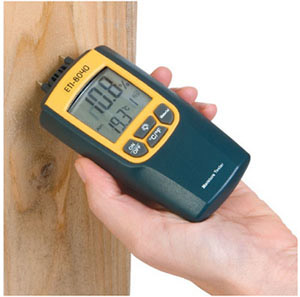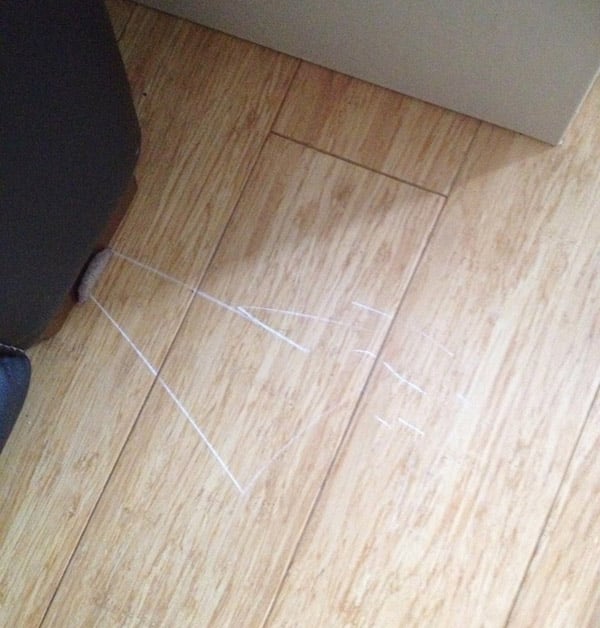As with all types of bamboo flooring and hardwood flooring, there may be some common problems that arise. This guide will help to highlight any issues and give advice on how to prevent problems from occurring in the first place, and how to solve problems that may arise once the floor has been installed.

Problem 1: wet or damp screed resulting in moisture damage to the floor
If the subfloor is not thoroughly dry before bamboo flooring is installed, over time the flooring planks will start to absorb this moisture and warp, distort and lift up.
|
How to prevent this from happening |
How to resolve it once it has happened |
| Before any bamboo flooring is laid, the subfloor must be moisture tested with the correct moisture metre. The moisture content (MC) should be below 6% MC when testing concrete, and 16% MC or below for wooden floorboards, plywood, chipboard or joists. If the subfloor is not dry it must be left to dry naturally and then tested again before installation of the flooring. If the subfloor is an old concrete or screed then a primer can be applied to seal the floor, before the MC is re-tested again. | If the moisture damage has already occurred and the flooring is warped, distorted or lifted then there is not much that can be done, other than taking up the flooring and laying new planks. Remember to moisture test the subfloor before any new flooring is laid, to prevent the problem from happening again. |

Problem 2: the subfloor is not level resulting in the floor moving
The subfloor needs to be completely level before any bamboo or hardwood flooring is installed. If it is not level then the planks of flooring may become damaged and crack, creak and move over time.
|
How to prevent this from happening |
How to resolve it once it has happened |
| The subfloor should be tested to ensure it is level before any bamboo flooring is installed. This can be done with either a straight edge or a spirit level.If the subfloor is not completely level then it must be levelled out. The two most common methods to do this are: to line the subfloor with plywood (at least 8mm thick), or use a levelling compound to level and smooth out the subfloor - it will then need to be left to dry and must be moisture tested before any flooring is installed (see above). | If the floor is already damaged (cracked and moving) then there is little that can be done to solve the problem, other than taking up the flooring, levelling the subfloor and installing new flooring. |
Problem 3: No expansion gap has been left resulting in the flooring warping
An expansion gap of at least 10mm should be left around the edge of the room (including doorways) to allow for the flooring to expand and contract naturally. If this is not done, there will be no room for natural movement and the flooring may warp, raise up and break.
Problem 4: Scratches or dents to the floor
If bamboo flooring is not looked after properly then scratches and dents will appear on the surface. These can be easily preventable.
|
How to prevent this from happening |
How to resolve it once it has happened |
| Dirt is the main cause of scratches and damage to the floor. Daily sweeping with a soft bristle brush and weekly cleaning with a wood floor cleaning spray and microfibre mop should help to prevent scratches. It is advisable to place doormats at entrances, and remove footwear to prevent dirt and stones reaching the floor. Anti-scratch felt pads can also be attached to the bottom of furniture to prevent scratches and dents. It is not advisable to drag heavy or sharp objects across a bamboo floor as this could cause significant damage. | If the flooring has been scratched or dented then it can be sanded and refinished. This is a major job and the whole floor will need doing, rather than just a small section. If it is only individual sections of the flooring that require work then it should be done by a professional floor finisher or French Polisher to ensure the finish matches the rest of the flooring. Another alternative is to use coloured beeswax that can mask over small scratches. |
Problem 5: Water damage to the floor resulting is distorted planks
If water is left to soak in to bamboo flooring then water damage can occur to the planks of flooring. This can cause the planks of bamboo to warp, distort and become discoloured.
|
How to prevent this from happening |
How to resolve it once it has happened |
| Water spills and accidents should never be allowed to sit on bamboo flooring for any amount of time. Spills should be wiped away immediately to ensure liquid does not soak into or underneath the floor. Another way to prevent water from damaging the floor is to remove shoes and other footwear before walking on the bamboo floor. Ideally they should left in a porch or garage and not on the bamboo floor. | If the floor has already been damaged by water and the planks are distorted and discoloured, there is little that can be done other than taking up the flooring, ensuring the subfloor is dry and then installing new flooring. |








